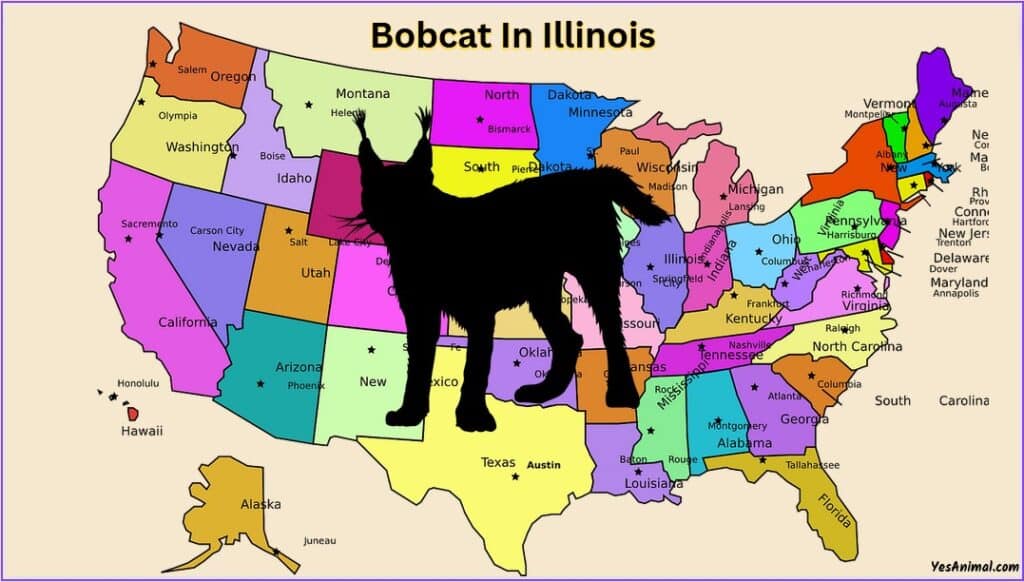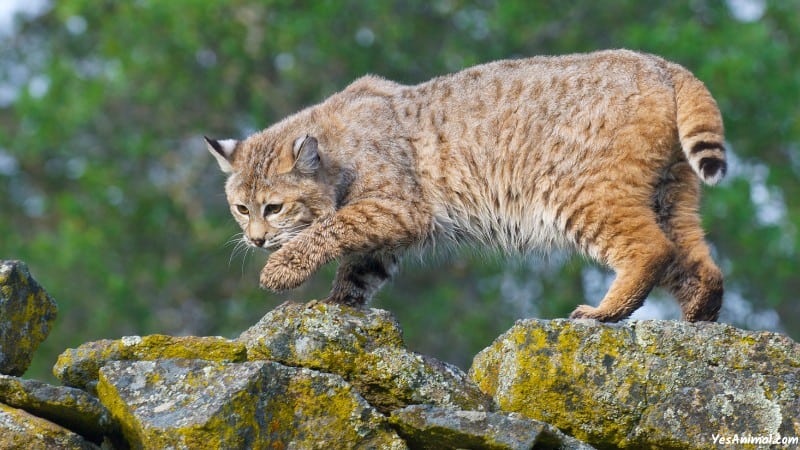Last Updated on September 14, 2023 by Amin Tawar

Illinois has some noteworthy fauna and plenty of wild animals in the state. However, in regard to wild cats, there is only one native species present in the state that roams around.
So are these wild cats, bobcats? In this article, I’ve explained everything you need to know about the bobcats in Illinois.
Are There Bobcats In Illinois?
Illinois is among those fortunate states in the U.S. that is home to a thriving bobcat population. During the 19th and earlier 20th centuries, bobcats were on the brink of extirpation as they were trapped or hunted for furs and as they posed a threat to livestock.
During the mid-1900s, these cats practically vanished from the state, and from the year 1977 to 1999, they were protected in Illinois as an endangered and threatened animal. The bobcat settlement in Illinois has grown from being endangered to flourishing, since 2016.
Bobcats were previously present throughout the Midwest’s areas of prairie woodlands, however, they were considered very rare in the Corn Belt area in the century that observed European settlement from the 1840s to 1940s.
Following their actual safeguard under the Wildlife Code, these cats were identified as a state-threatened species by the Illinois Department of Natural Resources (IDNR) in 1977.
Where Do Bobcats Live In Illinois & How common are bobcats in Illinois?
Although bobcats are widespread in the state of Illinois, they are mostly predominant only in the southern half of the state. Their home ranges can be pretty huge and prefer wooded habitat that is used for covering and denning areas, while fields and forest edges are mostly only used for hunting their prey. In southern Illinois, female and male bobcats have yearly home ranges of 3 to 6 square miles and 7 to 20 square miles, respectively.
Currently, it is estimated that there are around 5,000 bobcats living n the state, however, they are not very commonly spotted as bobcats are very shy and usually avoid human contact. But, sometimes they can be spotted in the human settlement areas where there are pet animals, livestock, or access to human food.
How Large Is A Illinois Bobcat?

Bobcats are around 2 to 3 feet in length from their tail to nose and can be about 2 feet in height at shoulder level. An adult male bobcat can weigh around 40 pounds and an average of 22 pounds. Adult female bobcats are usually smaller in size and slightly less in weight when compared to male bobcats.
They have long legs and short tails which can range from 4 to 6 inches. Bobcats have reddish-brown to yellowish fur with a few black streaks and spots throughout.
During the winter months, their fur is kind of grayish-brown and on the underparts, it is white with some dark spots. Bobcats have 5 and 4 toes on the front feet and back feet, respectively.
Also Check Our Guide On Bobcats In US
Are Bobcats Aggressive In Illinois?
No, bobcats in Illinois are not aggressive as they are very shy of humans. When you spot one in the forest or in the neighborhood, they might quickly pass by as they do not want to make interactions with humans.
Bobcats are territorial and solitary, they prefer to maintain to themselves and move on their path as they want to hide and run away from humans. Thus bobcats in Illinois are not aggressive or a dangerous threat to humans.
What Do Bobcats Eat In Illinois?
Though they are small in size, bobcats are tough and aggressive predators. Sometimes, especially in the winter, they kill animals that are many times bigger than them, like white-tailed deer and feral hogs.
However, their standard diet mostly consists of small animals like eastern cottontails, eastern gray squirrels, swamp rabbits, and various rodents.
They also consume reptiles, insects, birds, and carrion. When near residential areas, they occasionally prey on small livestock or pets like chickens or goats.
Occasionally they eat venomous snakes despite not being resistant to the venom. They achieve this by pinning the snake’s crown down using their paw and then they dispatch a swift bite to its backbone.
Can You Kill A Bobcat In Illinois?
Conservationists, especially trappers, and hunters, supported legislative actions for enhanced safeguarding and control of wildlife and forest spaces as wildlife digits dropped all over the nation.
However, with the help of modern wildlife managing theories bobcats were offered some security which improved their population of them. In 1999, bobcats were removed from Illinois’ list of state-threatened animals after being located in 99 counties of the state.
Today, supervisors watch out for the inhabitants and allow a controlled trapping and hunting season that permits a restricted amount of bobcat harvest without endangering the population.
Bobcats have joined the other animals of furbearers that have established hunting or trapping seasons in 2016. The standard bobcat trapping and hunting season usually is from early November to mid-February.
Can You Own A Bobcat In Illinois?
In Illinois, no individual can own any dangerous species, defined as a lion, leopard, tiger, ocelot, cheetah, jaguar, margay, lynx, mountain lion, and bobcat. There are a few exceptions to appropriately preserved zoological parks, circuses, federally licensed exhibits, educational or scientific institutions, veterinary hospitals, research laboratories, or animal refuges. Thus it is illegal to own a bobcat in Illinois.
Also Check Our Guide On Bobcat In Georgia
What To Do If You See A Bobcat In Illinois?
When you encounter a bobcat the foremost thing not to do is to run. As bobcats are predators, their intuition is to chase down their prey.
Thus running will only activate that instinct immediately. Face the bobcat and back away gradually as you make way for the cat to exit and it is not cornered. If the bobcat turns fierce, then try making big noises using your pots.
You can also try waving your hands above your head and attempting to make yourself seem bigger by raising your jacket. You can also try using an air horn or whistle.
You can also try throwing sticks, and rocks, and even pour water on them to leave you alone. As wild cats also choose to run away rather than fight with humans, it the best for you to stay calm and wait for it to move away.
Conclusion
And that was everything you need to know about the Bobcats In Illinois. I hope this article answered all your queries.
Thank You For Reading!
Our Goto Source For This Guide